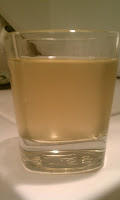To make kombucha tea, you need to have access to a kombucha scoby. Either get one from a friend, from Craigslist, from online, or you can grow your own!
Kombucha tea is most often fermented using a tea base with a good deal of sugar in it. Many people like to use black teas, but I personally like kombucha that is made with green or white teas. Its important to note that you should use actual tea, not herbal teas. Although you can technically use herbal teas, I would not recommend using them by themselves. You can, however, use them in combination with regular teas, should you desire to be creative.
 |
| A kombucha scoby |
Brew slightly less than one gallon of tea using the appropriate amount of loose leaf or bagged tea. Please note that you should steep different types of teas at different temperatures for different lengths of time, or else you risk over-steeping (this can make the tea taste too astringent and strong). Below, I have listed proper steeping temperatures and times:
- Black Tea: >200*F (rolling boil). Steep 4-6 minutes.
- Oolong Tea: Slightly less than boiling, around 190-200*F. Steep for 3-8 minutes (to taste)
- Puerh Tea: Slightly less than boiling, around 190-200*F. Steep to taste (some can steep for a very long time).
- Green Tea: 160-180*F. Steep for 2-3 minutes.
- White Tea: 150-160*F. Steep for 2-3 minutes.
 |
| Loose leaf jasmine green tea |
Add the sweet tea to your desired glass fermenter (do not, under any circumstances, use metal). The fermenter must have a large mouth so you can add and remove the scoby with ease. Allow the tea to cool to room temperature.
Once the tea is cool, add 1.5 cups of kombucha tea from a previous batch. If this is your first batch, then add either some raw kombucha tea that you've purchased from the store, or 2 Tbsp. of pasteurized white vinegar. Doing this will increase the acidity of the tea and help the scoby to thrive.
 |
| Its all ready to go! |
Gently add your scoby to the tea and secure a cloth onto the fermenter using a rubber band or twine. If you decide to use cheesecloth, make sure you use many layers of cheese cloth. The idea is to allow oxygen to permeate the cloth, but not bugs.
Be sure to put the kombucha in a place where it will not be exposed to direct sunlight or excessive heat or cold (no hotter than 90*F or colder than 60*F). Allow the kombucha to ferment, undisturbed (if you move the jar around, it breaks up the baby kombucha scoby that forms on the top of the tea), for 7 days. After 7 days, begin sampling your kombucha on occasion until it reaches your desired flavor and strength. When the kombucha is young, it is still relatively sweet. The longer it ferments, the stronger and tangier it gets. Some people like their kombucha fermented for 30 days or longer.
Once your kombucha has reached your desired taste, remove the scoby and place it in a bowl or other container (again, no metal), along with 1.5 cups of your fermented tea. Place it in the refrigerator until you want to brew another batch.
 |
| The baby scoby begins to form on the surface |
Allow the bottles/jars to sit at room temperature for around 48 hours. DO NOT SHAKE THEM! They can explode. After the 48 hours have passed, place one in the refrigerator, get it cold, and then sample it. If it is carbonated nicely, then place all of the other jars/bottles into the refrigerator as well. If they are not carbonated to your liking, then allow them to sit at room temperature for another 24 hours and then sample again. Again, do not shake the bottles when they are room temperature, as they can explode.
After your kombucha is carbonated to your liking, then enjoy! Drink to your health and share with your friends!

No comments:
Post a Comment
If you would like to post a comment, please keep it pertinent to the topic and suitable for all ages. Thanks!